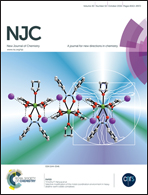A highly selective fluorescent sensor for the detection of Al3+ and CN− in aqueous solution: biological applications and DFT calculations†
Abstract
A new “turn-on fluorescence type” chemosensor 1 (N′1,N′2-bis((E)-2-hydroxybenzylidene)oxalohydrazide) with a simple structure was devised and synthesized. In aqueous solution, receptor 1 could efficiently detect both Al3+ and CN− at two different wavelengths. The limit of detection for Al3+ (2.0 μM) is below the World Health Organization (WHO) guideline for drinking water (7.41 μM). To utilize for practical and biological applications, the ability of 1 for monitoring Al3+ was tested in real water samples and living cells. In addition, 1 showed a highly selective fluorescence enhancement for CN− in the presence of other anions without any interference. The sensing mechanisms of 1 for Al3+ and CN− were supported by theoretical calculations.


 Please wait while we load your content...
Please wait while we load your content...